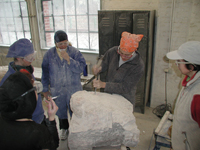 Editor: This is the first in a two part essay. The July/August Sculpture Northwest will have the second part.
Editor: This is the first in a two part essay. The July/August Sculpture Northwest will have the second part.
Last fall, I came to Germany as a facilitator of a Jewish-German reconciliation project. I never imagined then that I would fall in love with one of the German participants, and would soon return to Berlin to live and work until she could move to the States. Now I am learning to bridge our different worlds. How will I sculpt while I am in Germany and what will I do with the sculptures once I am done with them?
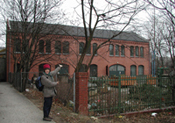
So, as my love relationship grew with Lisa Beuermann, I found myself back in Berlin in the cold of winter. Before arriving, I had emailed Amy Brier (a former Camp Brotherhood instructor whom many of you met in the mid-nineties), who sculpts in Berlin. I scheduled to help her split stone for an upcoming workshop and then serve as her assistant. I arrived on a Sunday night mid-January and on Wednesday morning I had the hammer drill in hand and was splitting 1-2 ton blocks of Kalkstein (limestone). After that day of splitting, I slept 14 hours. The jet lag had finally hit me and for the next three days, I slept 12 hours each day. Well, maybe you don’t want to know about the adjustments to make when flying over here, but PLAN ON IT!!!
Now the fun began! How do I find my way around Berlin, and get to the studio each day? Amy gave me the best route by the U-Bahn (subway). She told me that she would meet me the first day at the end of the train line U-9. So I packed a lunch that first morning and headed out on a 10 minute walk to the U-Bahn. I noticed that the sidewalk was made of large granite blocks surrounded by cobble stones making a beautiful mosaic pattern in front of each person’s home. The houses have archway entrances with lots of carving. I enjoyed all the different styles of shaping and texturing. Once at the U-Bahn station, I used the touch screen (with an English option) to figure how to purchase and validate my ticket. For two hours of travel the cost was 2.10 Euro, about $2.75 since GW Bush has been on the warpath. The train ride is 12 stops and takes about 20 minutes.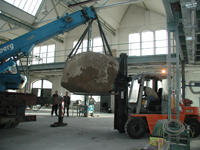
We met at the end of the line and walked a couple of blocks to the Bildhauerwerkstatt (www.bbk-kulturwerk.de/eindex.htm). An old brick and glass factory that once made safes, it sits beside a small river with ducks and trees. The cobblestone driveway was beautiful. When it rained, the colors of the large cobbles come out. I’d like to make a sculpture with the likes of them. The Werkstatt has really high ceilings with lots of windows. It has studios for stone, wood, metal, mold making, and ceramics. They charge by the day, week, or month for use of the studio space. It costs about $300 per month to rent space there with the use of air and power tools, and vacuum systems to catch the dust coming off the diamond blades, or clean the holes from the hammer drill. Think Metric! Angle grinders are available if you have your own diamond blade and abrasives. The air tools take slightly different fittings. European power is 240Volts, so all our power tools are of no use there. There are forklifts and gantry cranes for moving big stones and a crane operator can be hired to unload and place really big ones. About a dozen artists are working there each day. There is a staff of 4 that help with the forklifts and other power tools when needed. A tool supplier shows up when needed, selling the Rexid line of tools. These are available to US sculptors through the Grand Quartz company in Georgia. The prices are much cheaper in Germany.
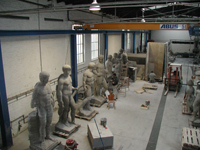
The class began on Monday with more stone splitting. Some of the split stones weighed in at 700 pounds or more-too much for this five-day class. So some of the blocks got split into smaller pieces. All the students were women, and fairly new at stone sculpting. I was very impressed by their determination to realize their ideas in such large blocks. For my help, I was given a chunk that weighed about 115#. The stone was brittle and didn’t yield very well to any size of chisel. So I used a point as my main tool to reach my desired shape. Over the next five days, the stone chips flew, as the ladies carved the big blocks of limestone. At first, I did the drilling and the cutting and helped Amy give instruction and encouragement. But soon each student was working alone. Each day at 5 PM a horn sounded for clean up prior to the 5:30 closing of the building (which is only open Monday-Friday). As none of the students finished her sculpture that week, the stones were left on pallets or bankers for completion at arranged times.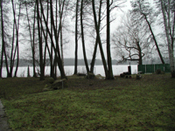
In addition to working with Amy, I had the great pleasure of meeting Kai-Uwe Drager, a middle-aged stone mason who owns a natural stone company sited near a big lake in northwest Berlin. He converted an old trolley-car depot into a studio with 15 full-time employees who work on landscape architecture for school playgrounds and parks and sculpture restoration. After a short tour with Amy and Lisa, he offered us a place to sculpt, and in the warmer weather, a great carving site beside the lake.
I talked to him about a mini symposium for stone sculptors and he was very interested. Anyone want to carve in Germany? He wants to develop a place where artists can work on projects up to 12 meters (37+ feet) in size. He would offer all necessary support services for the installation, with structural engineering, base making, landscape architecture, and labor (at a price of course). He is interested in working with artists from all over the world. He said that there is no problem in packing and shipping pieces to any place in the world. He offered also to go and help with the installation if needed. So another great contact is made. Check out www.steinforum.de for Kai’s contact info.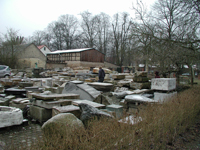
I had no difficulty in bridging the worlds. After a March-April visit I plan to return again in August and October. If you are planning on coming to Germany to carve, or want information on the Jewish-German project, please send me an e-mail or send me a letter. Email is This email address is being protected from spambots. You need JavaScript enabled to view it. and address is PO Box 975, Suquamish, WA 98392.

